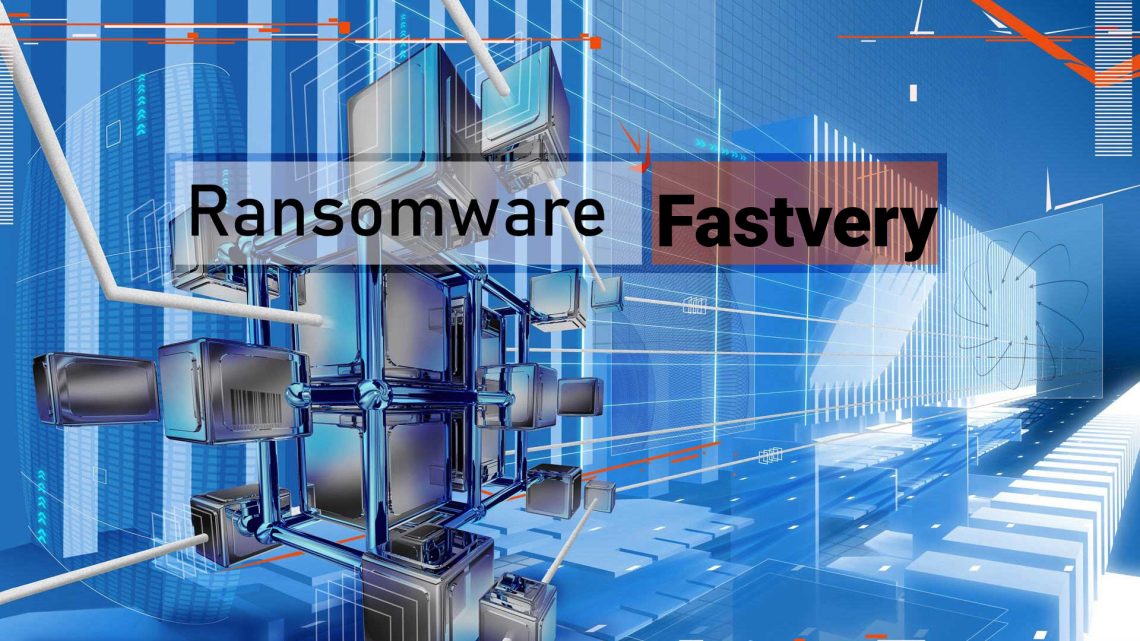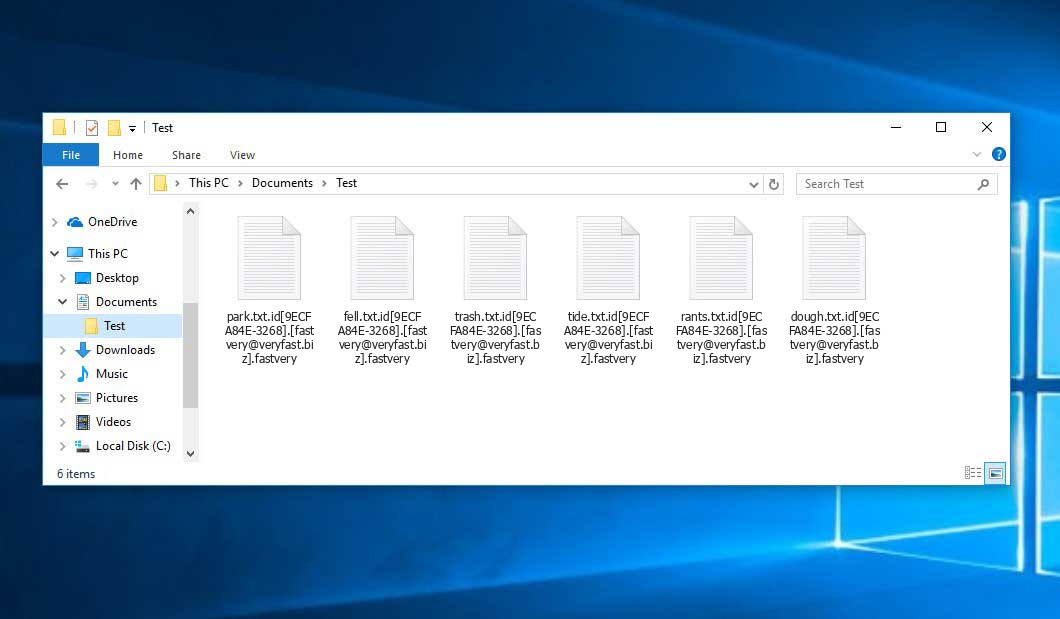The Fastvery virus falls under the Phobos ransomware family. Harmful software of this type encrypts all user’s data on the PC (photos, documents, excel tables, audio files, videos, etc) and appends its specific extension to every file, creating the info.txt files in every directory which contains the encrypted files.
Fastvery virus: what is known so far?
☝️ A scientifically correct denomination for the Fastvery would be “a Phobos family ransomware-type infection”.
The pattern of renaming is the following: %victim-ID%.%contact-email%.fastvery. In the course of encryption, a file entitled, for instance, “report.docx” will be changed to “report.docx.id[9ECFA84E-3268].[[email protected]].fastvery”.
In every folder containing the encoded files, a info.txt file will be created. It is a ransom money memo. Therein you can find information about the ways of contacting the racketeers and some other remarks. The ransom note most probably contains instructions on how to purchase the decryption tool from the Fastvery developers. You can get this decryptor after contacting [email protected] by email. That is it.
Fastvery summary:
| Name | Fastvery Virus |
| Ransomware family1 | Phobos ransomware |
| Extension | .fastvery |
| Ransomware note | info.txt |
| Contact | [email protected] |
| Detection | DropperX-gen [Drp], Win32/Injector.AUDU, Win32/FlyStudio.Injector.D potentially unwanted |
| Symptoms | Your files (photos, videos, documents) get a .fastvery extension and you can’t open them. |
| Fix Tool | See If Your System Has Been Affected by Fastvery virus |
The info.txt file coming in package with the Fastvery malware provides the following frustrating information:
!!!All of your files are encrypted!!! To decrypt them send e-mail to this address: [email protected]. If we don\'t answer in 24h., send e-mail to this address: [email protected]
In the picture below, you can see what a folder with files encrypted by the Fastvery looks like. Each filename has the “.fastvery” extension added to it.
How did Fastvery ransomware end up on my PC?
There are plenty of possible ways of ransomware infiltration.
Nowadays, there are three most popular methods for tamperers to have the Fastvery virus acting in your system. These are email spam, Trojan injection and peer file transfer.
If you open your mailbox and see emails that look just like notifications from utility services companies, delivery agencies like FedEx, Internet providers, and whatnot, but whose mailer is strange to you, beware of opening those emails. They are most likely to have a malicious item enclosed in them. Thus it is even more dangerous to open any attachments that come with letters like these.
Another thing the hackers might try is a Trojan horse model2. A Trojan is a program that gets into your computer pretending to be something else. Imagine, you download an installer for some program you want or an update for some software. But what is unpacked turns out to be a harmful program that encrypts your data. Since the installation wizard can have any name and any icon, you’d better be sure that you can trust the source of the files you’re downloading. The best thing is to use the software companies’ official websites.
As for the peer-to-peer file transfer protocols like torrent trackers or eMule, the danger is that they are even more trust-based than the rest of the Web. You can never know what you download until you get it. So you’d better be using trustworthy resources. Also, it is reasonable to scan the directory containing the downloaded items with the anti-malware utility as soon as the downloading is finished.
How to remove the Fastvery virus?
It is crucial to note that besides encrypting your data, the Fastvery virus will most likely deploy the Azorult Spyware on your computer to seize your credentials to different accounts (including cryptocurrency wallets). The mentioned spyware3 can extract your credentials from your browser’s auto-filling data.
Sometimes tamperers would decrypt few of your files so you know that they really have the decryption program. Since Fastvery virus is a relatively recent ransomware, anti-malware engineers have not yet found a way to undo its work. However, the decoding tools are frequently upgraded, so the solution may soon be available.
Of course, if the tamperers do the job of encoding someone’s critical files, the hopeless person will most likely comply with their demands. Despite that, paying to racketeers does not necessarily mean that you’re getting your files back. It is still dangerous. After getting the money, the racketeers may send a wrong decryption code to the victim. There were reports of criminals just disappearing after getting the money without even writing back.
The optimal countermeasure to ransomware is to have aan OS restore point or the copies of your essential files in the cloud storage or at least on an external storage. Surely, that might be not enough. The most crucial thing could be that one you were working upon when it all went down. But at least it is something. It is also reasonable to scan your drives with the antivirus program after the system is rolled back.
Fastvery is not the only ransomware of its kind, since there are other specimens of ransomware out there that act in the same manner. For instance, Ygvb, Tuid, Udla, and some others. The two main differences between them and the Fastvery are the ransom amount and the encoding method. The rest is the same: documents become encrypted, their extensions changed, ransom notes emerge in each directory containing encoded files.
Some fortunate users were able to decrypt the arrested files with the help of the free software provided by anti-malware experts. Sometimes the racketeers accidentally send the decryption key to the victims in the ransom readme. Such an extraordinary fail allows the victim to restore the files. But of course, one should never expect such a chance. Make no mistake, ransomware is a tamperers’ technology to pull the money out of their victims.
How сan I avoid ransomware attack?
Fastvery ransomware has no endless power, so as any similar malware.
You can armour yourself from its injection in three easy steps:
- Ignore any letters from unknown senders with unknown addresses, or with content that has nothing to do with something you are waiting for (can you win in a money prize draw without even taking part in it?). If the email subject is more or less something you are expecting, check all elements of the questionable email carefully. A fake email will always contain a mistake.
- Never use cracked or untrusted programs. Trojans are often spreaded as an element of cracked products, possibly as a “patch” preventing the license check. But untrusted programs are difficult to distinguish from reliable software, because trojans sometimes have the functionality you seek. Try searching for information about this program on the anti-malware forums, but the best solution is not to use such software.
- And to be sure about the safety of the objects you downloaded, check them with GridinSoft Anti-Malware. This software will be a perfect shield for your system.
Reasons why I would recommend GridinSoft4
There is no better way to recognize, remove and prevent ransomware than to use an anti-malware software from GridinSoft5.
Download Removal Tool.
You can download GridinSoft Anti-Malware by clicking the button below:
Run the setup file.
When setup file has finished downloading, double-click on the setup-antimalware-fix.exe file to install GridinSoft Anti-Malware on your PC.

An User Account Control asking you about to allow GridinSoft Anti-Malware to make changes to your device. So, you should click “Yes” to continue with the installation.

Press “Install” button.

Once installed, Anti-Malware will automatically run.

Wait for the Anti-Malware scan to complete.
GridinSoft Anti-Malware will automatically start scanning your system for Fastvery infections and other malicious programs. This process can take a 20-30 minutes, so I suggest you periodically check on the status of the scan process.

Click on “Clean Now”.
When the scan has completed, you will see the list of infections that GridinSoft Anti-Malware has detected. To remove them click on the “Clean Now” button in right corner.

Frequently Asked Questions
🤔 Are the “.fastvery” files accessible?
There’s no way to do it, unless the files “.fastvery” files are decrypted.
🤔 I really need to decrypt those “.fastvery” files ASAP. How can I do that?
If the “.fastvery” files contain some really important information, then you probably have them backed up. In case you haven’t, there is still a chance that you do have a Restore Point from some time ago to roll back the whole system to the moment when it had no virus yet, but already had your files. All other solutions require time.
🤔 If GridinSoft deletes the Fastvery malware, will it also delete my files that were encrypted?
Of course not. Unlike the ransomware program itself, the encrypted files do not jeopardize your system.
GridinSoft Anti-Malware will remove active threats from your system. The malware that has attacked your PC is most likely still functional and running scans from time to time to encrypt any new files you might create on your PC after the infection. As it has been said above, the Fastvery malware comes with the company. It installs backdoors and keyloggers that can steal your account credentials and provide malefactors with easy access to your system after some time.
🤔 What should I do if the Fastvery malware has blocked my computer and I can’t get the activation code.
In such an unfortunate situation, you need to prepare a flash memory drive with a pre-installed Trojan Killer. Use Safe Mode to execute the procedure. You see, the ransomware runs automatically as the system boots and encrypts any new files created or imported into your system. To stop this function – use Safe Mode, which allows only the vital programs to run automatically. Consider reading our manual on running Windows in Safe Mode.
🤔 What can I do right now?
Many of the encrypted files might still be within your reach
- If you sent or received your critical files by email, you could still download them from your online mail server.
- You may have shared photographs or videos with your friends or relatives. Simply ask them to send those pictures back to you.
- If you have initially got any of your files from the Web, you can try downloading them again.
- Your messengers, social media pages, and cloud disks might have all those files as well.
- Maybe you still have the needed files on your old PC, a portable device, mobile, memory stick, etc.
USEFUL TIP: You can use file recovery utilities6 to retrieve your lost information since ransomware encodes the copies of your files, removing the authentic ones. In the video below, you can learn how to use PhotoRec for such a restoration, but remember: you won’t be able to do it before you remove the virus with an anti-malware program.
Also, you can contact the following official fraud and scam sites to report this attack:
- In the United States: On Guard Online;
- In Canada: Canadian Anti-Fraud Centre;
- In the United Kingdom: Action Fraud;
- In Australia: SCAMwatch;
- In New Zealand: Consumer Affairs Scams;
- In France: Agence nationale de la sécurité des systèmes d’information;
- In Germany: Bundesamt für Sicherheit in der Informationstechnik;
- In Ireland: An Garda Síochána;
To report the attack, you can contact local executive boards. For instance, if you live in USA, you can have a talk with FBI Local field office, IC3 or Secret Service.
I need your help to share this article.
It is your turn to help other people. I have written this article to help people like you. You can use the buttons below to share this on your favorite social media Facebook, Twitter, or Reddit.
Brendan SmithHow to Remove FASTVERY Ransomware & Recover PC

Name: FASTVERY Virus
Description: FASTVERY Virus is a ransomware-type infections. This virus encrypts important personal files (video, photos, documents). The encrypted files can be tracked by a specific .fastvery extension. So, you can't use them at all.
Operating System: Windows
Application Category: Virus
User Review
( votes)References
- My files are encrypted by ransomware, what should I do now?
- You can read more on Trojans, their use and types in the Trojan-dedicated section of GridinSoft official website.
- You can read more on spyware variants and nature in the respective section of GridinSoft official website.
- GridinSoft Anti-Malware Review from HowToFix site: https://howtofix.guide/gridinsoft-anti-malware/
- More information about GridinSoft products: https://gridinsoft.com/comparison
- Here’s the list of Top 10 Data Recovery Software Of 2023.



